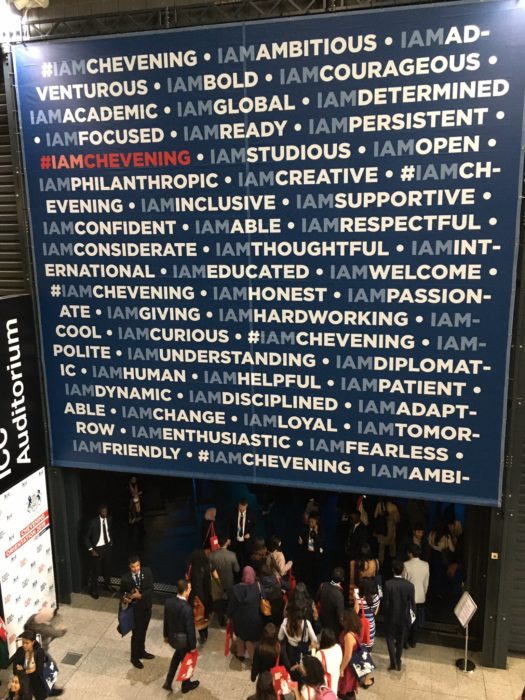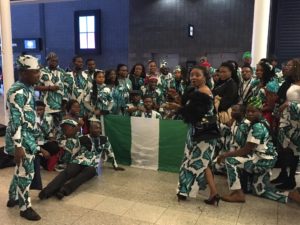13th October 2019 London,UK
What is Chevening?

It was great to have the opportunity to speak to our 1,750 new Chevening Scholars yesterday at the exuberant event that is Chevening Orientation. This is what I said.
What is Chevening?
Chevening is a place.
It is a large rural mansion house in the English county of Kent, to the south-east of London, built in the early 17th century.
The story of how this country house gave its name to the Chevening scholarships programme is closely linked to the history of an English aristocratic family named Stanhope.
The title of Earl Stanhope was created in 1718 for James Stanhope, a prominent military commander who then pursued a career as a politician, supporting the Hanoverian Succession and thus the reign of King George I. He became Prime Minister in all but name, and indeed he is sometimes described as Britain’s first Prime Minister, a title which goes officially to Sir Robert Walpole. He had purchased Chevening House in 1717, and greatly extended it, befitting his new status.
Stanhope was sadly tainted by the scandal around the South Sea Bubble, named after a company created to consolidate and reduce the cost of the national debt, whose collapse ruined many people. Following a particularly tough debate in the House of Lords, Stanhope took ill, and died.
His successors as Earl combined to varying degrees political and public service, scientific enquiry and eccentricity.
The Third Earl was a politician sympathetic to the French Revolution. His was somewhat a lone voice in parliament on the matter. He was also a noted scientist, giving his name to a printing press and a lens.
The Fourth Earl is best remembered today for his association with the Kaspar Hauser case. This related to a young man who turned up in the German city of Nuremberg in 1828 claiming to have been raised alone in a darkened room, knowing nothing of his identity. Stanhope befriended Hauser, became his foster father, and launched investigations to establish his background, the fruitlessness of which however ended up convincing Stanhope that Hauser was a liar and fantasist. Hauser obtained a deep wound in his chest in 1833, saying a stranger had stabbed him. Stanhope thought it had been self-inflicted. Either way, it was a serious injury. Hauser died shortly afterwards.
The Fifth Earl, a parliamentarian and historian, was one of the main proponents of the National Portrait Gallery, opened in London in 1856.
James Stanhope, the Seventh Earl, was a Conservative politician, whose many roles included those of Leader of the House of Lords and, in the run-up to the outbreak of the Second World War, First Lord of the Admiralty. He was one of the politicians accused in some quarters of failing to prepare Britain for the Second World War, and taking an excessively soft line towards Nazi Germany.
James Stanhope had a problem. His wife had died young. He was childless, with no close relatives. As he approached the end of his life, he began to think of his legacy. He wanted to create a lasting reminder of his family’s long and close ties with political service. What he alighted on was the Chevening Estate Act of 1959, designed to ensure that the house would play a key part in public life.
Ownership of the house was vested in a Board of Trustees, charged with maintaining it as a furnished country residence for a suitable Nominated Person. The nomination is made by the Prime Minister, but the Chevening Act limits who they can choose, to Cabinet Ministers and descendants of King George VI. The Nominated Person from 1974-80 was His Royal Highness the Prince of Wales, but following his purchase of Highgrove in Gloucestershire the Nominated Person has usually been the Foreign Secretary.
And this brings us to the second answer to the question, what is Chevening?
Chevening is a scholarship programme.
It was launched in 1983, thirty-six years ago, as the Foreign and Commonwealth Office Awards Scheme, aimed at bringing exceptional individuals from right around the world to study in the UK. It unites students with world-leading UK universities, helping you to develop your potential as future leaders in your chosen fields. In 1994 it was decided that, though the scheme was great, it needed a snappier name, and the new choice, Chevening, took its title from that house in Kent, the official country residence of the Foreign Secretary.
The Chevening programme has grown, this year welcoming all of you, some 1,750 great students from 141 countries and territories, who will be studying at 117 UK universities. Graduates of the scheme have gone on to glittering careers. The first Chevening alumnus to become Prime Minister of their country was Rinchinnyam Amarjagal in Mongolia in 1999, and he has been followed by many more.

But whether it is in politics, or health, or education, or civil society development, graduates of the programme are transforming lives and communities in their home countries. As UN sustainable development goal 4 puts it, obtaining a quality education is the foundation to improving people’s lives and sustainable development. The Chevening Scholarships programme will not in itself make you an agent for positive change in your country. You have been selected for a Chevening Scholarship because that potential is already within you. But the scholarship will help you realise it.
We are proud of the fact that Chevening is a scholarship for the very best, helping you to become the global leaders of the future. But Chevening is not just a scholarship programme. And this brings me to my third answer to the question, what is Chevening?
Chevening is a community.
The programme now boasts more than 50,000 alumni. We hope that graduates of the scheme will remain lifelong friends of the UK. Friends who understand us, and can be open with us. And we hope too that graduates of the scheme will remain lifelong friends of each other, cemented through the activity of Chevening alumni associations around the world.
This process of building Chevening as a community starts today, at Orientation, and continues through your time in the UK. The academic programmes you will be undertaking will keep you busy, very busy, but Chevening is not just about your courses of study. You have opportunities to help understand and transform communities in the UK by volunteering with charitable organisations ranging from The Prince’s Trust to Oxfam. Volunteering is a great way of connecting with the UK beyond your university.
Rayon McLean, a Chevening Scholar from Jamaica, volunteered with youth theatres, and put it like this:
“Volunteering for this cause was my quickest way of connecting to the heart and soul of London. It brought me beyond the surface and into a London where communities are being built through art and courage.”
And do take the opportunity of your time in the UK to explore its nations, cities and countryside. The Chevening Relay provides a great spur to getting out and about. This is not just a competition between red and blue batons. Gerald the Giraffe managed to visit quite a few relay sites last year. He thinks he can do even better this one.

So from a country house in Kent, the name of Chevening has become associated with not just a prestigious scholarship scheme, but also with a global community of 50,000 leaders and change makers, their numbers increasing every year, bonded together by their Chevening experience. I think James, the Seventh Earl of Stanhope, should feel pretty happy with that.
Have an awe-inspiring year. Change the world.
This is really great information. I feel a part already. Good luck with my interviews tomorrow!
Hey Emmanuel. How did it go? I’m looking forward to mine tomorrow. Fingers crossed.
Reading this article as an aspiring Chevening scholar, I now have a clear and better understanding of what Chevening really is and how the name came to be. Hoping to witness this in person, thank you!
Thank you, and best of luck with your application!
Thank you for such an inspiration and touching speech during the orientation. It was quite a memorable moment to witness such great event.
Delighted you enjoyed it!
This was my favourite speech at the orientation. Now I have a better understanding of what Chevening is about.
Thank you!
I found this speech truly inspirational. I am encouraged and I am glad to be part of the Chevening Community. Once more, I am grateful for the opportunity!
Delighted that you enjoyed it!
This statement got the highlights of the orientation! I will use my Chevening expertise, Chevening network and Chevening resilience to transform my community/country and touch the world powerfully. That’s the impact of the Chevening scholarship!
Great to hear, and good luck!
The opportunity of connecting and cultivating relationships with other 1,749 chevening scholars is unmeasurable. Speaking to some of them during our networking sessions made me appreciate the diverse talents Chevening has brings together each year. Thinking of the fact that the world has got over 50,000 of them out there influencing communities, institutions and nations makes me feel blessed to be part of this enormous family.
To me chevening initiates a relationship with the UK, the people and the communities I will be fortunate to volunteer with and I can never take that for granted.
What a great message!
It was a pleasure learning more about the history of this life changing opportunity. I felt like i was part of the crowd. You are giving leaders skills and networks to make this world a better place creating common understanding and cooperation between different cultures.
If granted life, I hope to be joining the community next year.
I will leave you to an old saying that goes something like “Give a man a fish and you feed him for a day; teach a man to fish and you feed him for a lifetime” – Maimonides
Thank you and good luck in your application!
You not only availed the much needed wisdom for me as a new chevening scholar , but your speech’s rich historical perspective adds a rich reference to the Chevening community , in your speech ,you gave us a Transgenerational wisdom and passed on the Button to generations yet unborn.
I am glad to have been in attendance and thank you for Wisdom.
#iamchevening
#mycheveningjourney
Delighted you enjoyed it!
Glad you enjoyed the speech!